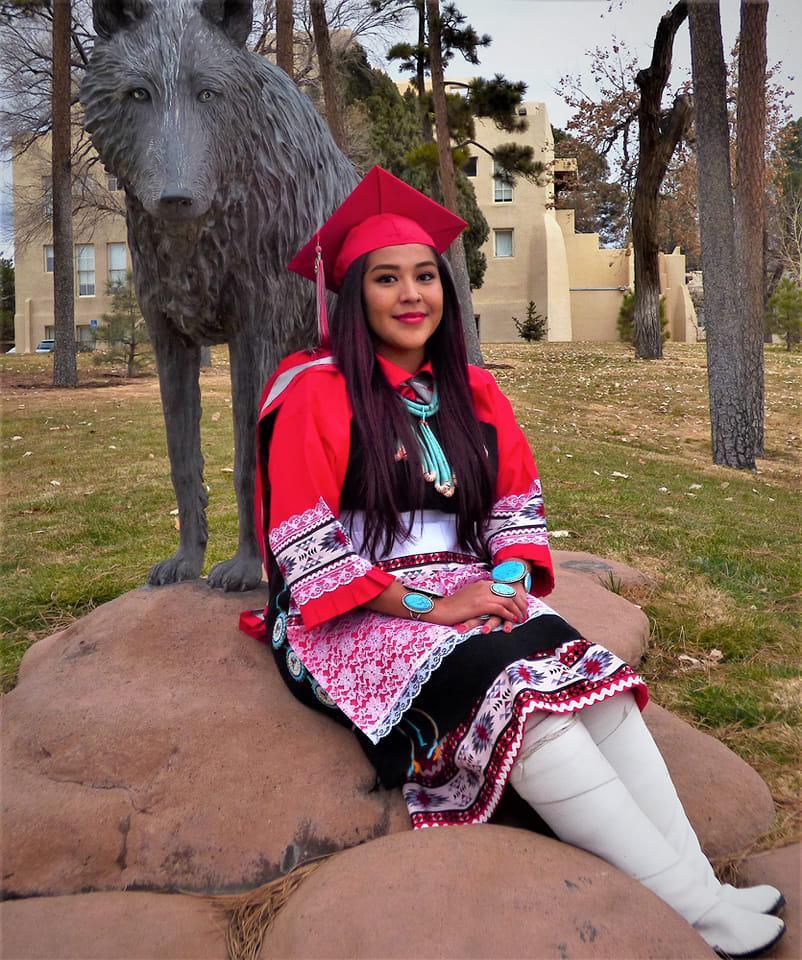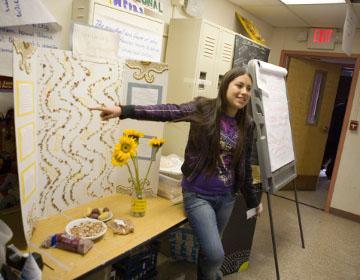Curriculum

At NACA, we believe that to preserve one’s language is to preserve one’s culture. We also recognize that many colleges require a language component. Therefore, we offer classes in Navajo at elementary through high school, as well as Dine Government specifically for High School students. We also offer Lakota, Keres, Tiwa, and Zuni language classes from elementary through high school. Students can also take Spanish I, II an III in high school. Read more about NACA’s approach in the report Indian Education in New Mexico: 2025, where we were featured as a school using best practices for culturally responsive education.
In addition to all that students learn in a formal classroom setting, NACA places strong importance on experiential learning through Academic Activities and Learning Trips, Out-of-School Time Learning, and other Special Programs.
Credit Requirements by Grade in Alignment with State Graduation Requirements
Examples of NACA classes are listed below.
Math: NACA’s math philosophy is grounded in inquiry. Students learn best through hands-on problem solving activities. This philosophy provides students with opportunities to build upon their previous experiences, gain conceptual understandings and increase critical thinking skills. Numeracy is fostered through the Eureka Math Squared Math Program in elementary and middle school. We utilize Interactive Math Program in high school. An example of this includes:

Science: NACA’s science philosophy is grounded in inquiry. Hands-on problem solving activities are integrated into the exploration of science in a way that is relevant and fun for each grade level that includes projects inside and outside of the classroom. General investigation, life, earth, the environment and biology are all topics that are “uncovered” in Science. An example includes:
- The 6th Grade Science course is designed to introduce students to the scientific process, inquiry, and concepts in the areas of Earth and Space, Physical, and Life. In this course, students use inquiry to investigate various science phenomena and follow the scientific process to develop their own scientific investigations.
Language Arts: English/language arts classes foster literacy skills and knowledge. In elementary through the high school level, our students engage in English/Language Arts through a connected approach to Indigenous cultures. Students in middle school and high school also are engaged in Native Literature and tiered reading classes. Examples include:
- The 6th grade Language Arts curriculum is primarily focused on narrative writing. Accordingly, students learn and identify the 6+1 Traits of writing and enhance Organization, Voice and Conventions in their personal narratives. In addition, a daily grammar and spelling program (Spellography) is implemented to increase students’ word knowledge.
- Ninth Grade English, which focuses on the essential question “How does the global community impact me?” This question is addressed from as far away as Iran in the reading of Persepolis, a graphic novel about a young Persian girl, to the very personal, with an end of the year poetry unit. The class is project-centered with the motto that language is an art form that can be articulated and communicated in many ways beyond standard academic writing.
- Tenth Grade English is focused on world literature and the research writing process. The curriculum is designed to support the content taught in 10th grade Social Studies, and students work on a National History Day project between both classes. During the fall semester English students read Lord of the Flies and select a second classic English text to compare to it, while beginning background research for the NHD competition. During the spring semester students complete their NHD contest entry as well as an academic paper on their topic; at the end of the year we read excerpts from religious texts while they study world religions in Social Studies.
- Seventh Grade Language Arts is a project-based class that encourages students to develop writing skills though a focused approach. Students are introduced to the Four Square Writing Process, Jane Shaffeuer’s Writing Strategies, R.A.C.E. and 6+1 Writing Goals. Through these methods students are challenged to write in four genres; descriptive, narrative, expository, and persuasive while increasing vocabulary and grammar development.
Music: NACA Rocks is the alternative music program that, unlike traditional school bands and orchestras, focuses exclusively on rock music. The program was designed to enhance the benefits of music in schools by widening the appeal to students who excel in alternative music forms. Kids who would not normally become involved in school music are now experiencing the advantage of playing in school: better grades, better attendance, and higher performance levels. The NACA Rocks band performs at all of the school’s functions, giving students the same performance experience that they would have in a more traditional music.

- Eighth Grade U.S. History, which uses projects to provide a window into the United States Government for middle school students. While learning United States history and Native American history through a balanced approach, students are challenged to think critically and draw their own conclusions about US history. Through student participation in the National History Day event students can actively engage in studying primary documents and develop research skills in a context that is relevant to their roles as a US citizens, community members, and tribal members in their own communities.
Native Literature: NACA’s Native Literature courses provide students with an opportunity to master reading strategies while exploring works from Native American Fiction and Non-Fiction authors. Students learn to analyze and question the text they read, build vocabulary knowledge, apply tools for effective paragraph structure, and build test taking strategies, all while learning about culture and identity. For example:
- Sixth and Seventh Grade Native Literature classes are designed to foster a love of reading and an awareness of identity in students while helping them improve their reading skills. The class regularly visits the library, and studies morphemes to help improve vocabulary and integrate the NACA Core Values. A collection of audio books is provided to support struggling readers, and weekly reading conversations allow students to explore what their classmates read outside of school. Native authors include Velma Wallis, Virginia Driving Hawk Sneve, and Devon Mihesuah.
- At the eighth grade level, the Native Literature course focuses on literature written by native authors to develop reading and analytical skills. The class reads several novels together, as well as a variety of short stories, poems, and nonfiction. Students complete journaling and formal writing assignments, and participate in seminars and class discussions. Through weekly reading conversations, students pursue their individual reading interests and share those experiences with their classmates. Native authors studied include Sherman Alexie, Michael Dorris, Mary Crow Dog, and Leonard Peltier.
Navajo Language: The Navajo Language program gives students the opportunity to learn the Navajo language and cultural foundation including traditional values that identify Navajo youth. The program is for both non-speakers and speakers. Students gain an understanding of language learning through total physical response, language demonstration, hands, visuals, media KTNN radio station in oral language and the Navajo Times newspaper. Students develop an understanding of spoken communication by listening, reading and writing.

Lakota Language: The Lakota Language Program provides the opportunity for Native American students to explore the Lakota language while learning about Lakota culture, history, spirituality, art, food, and other topics. Through the program, Native American students learn basic oral and written Lakota vocabulary and grammar. In addition, the Lakota Language Program continues to advance students’ skills and knowledge in literacy (reading, writing, and speaking), social sciences, natural sciences, and visual and fine arts, while enhancing their connection to community, history, and culture. See photos of Lakota class activities.
Tiwa Language: The Tiwa language class at NACA was introduced after multiple requests from parents at students interested in learning their language. After consulting with the Isleta Department of Education, the already existing Tiwa curriculum was transferred to NACA and is taught at both the middle and high school levels by teachers from Isleta Pueblo’s program. Of the roughly 40 Isleta students, about half are currently enrolled in Tiwa classes.
Zuni Language

Keres Language
Indigenous Arts: From traditional Native crafts to skateboard design competitions, NACA students are exposed diverse and meaningful opportunities in visual arts. Additionally, through collaboration with the Institute of American Indian Arts in Santa Fe, adjunct-Professor Ms. Sunrise teaches art at NACA under the “Expanding the Circle” program that focuses on the success of native youth in higher education and beyond. See examples of students work.
Personal Wellness: Health and wellness are the focus of NACA’s Personal Wellness classes which are offered from grades Kindergarten through the 10th Grade. Personal Wellness courses at NACA focus on all aspects of wellness: Physical, Emotional, Intellectual, and Community/Service; unlike traditional Physical Education. The goal is for each student to obtain “Total Wellness.” By being exposed to various health issues, making healthy decisions and having great self esteem students gain the tools to live long healthy lives. For example:
- In Eighth Grade Personal Wellness, the year’s curriculum reflects the four quadrants of the Wellness Wheel. Each class involves a physical workout followed by coursework, and the homework is to keep track of food and exercise in the agenda. During the first quarter students work on Social/Emotional Wellness, completing “about-me” projects. Quarter two focuses on Community/Relationship Wellness; students participate in experiential education activities and travel to UNM to do a low ropes course. Quarter three is devoted to both Intellectual Wellness and Physical Wellness with a unit on Sexual Health. Finally, quarter four returns to Community/Relationship Wellness as students compile data from their year-long Food & Exercise diary and create PSAs.